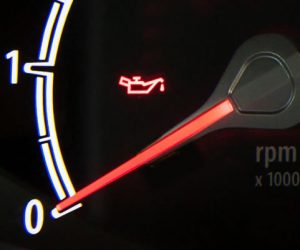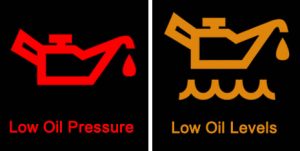The oil pressure light is on because either there’s not enough oil circulating in the engine to keep critical components lubricated and friction-free, or that the engine oil pump has a fault and is not circulating oil either sufficiently or at all.

What Should I do if the Oil Pressure Light Comes on?
If the oil pressure light comes on, as soon as it’s safe to do so, pull over and immediately turn off the engine. Try and stop in the least hazardous place possible for other road users as it’s there’s a chance that you’ll be unable to use your car. You’ll now need to investigate the issue to establish which actions to take next.
If I don’t Stop, What Might Happen?
If the fault is due to low oil pressure, friction on the internal engine components will continue to increase. Friction and excessive heat will result in your engine seizing, causing catastrophic damage.
Actions to Take
An oil dashboard symbol requires attention, particularly if it is red or flashing. Here’s what to do if your oil light comes on:
1. Oil Pressure or Oil Level?
If possible, establish whether the fault is related to the oil pressure or oil level. Some vehicles use the same dashboard symbol for both, where as others have separate symbols. If it is a yellow low oil level symbol, you should be good to carry on with your journey providing you top up with oil soon. If the symbol is red, or red flashing, pull over as soon as safe to do so and turn off the engine.

2. Check Oil Level
Open the bonnet / hood of the car, locate the dip stick and check the engine oil level. If oil level is low, replenish oil until it reaches the appropriate marker on the dip stick. If engine oil levels do not require topping up, avoid restarting the engine as damage may occur. If you have topped up the engine oil, restart the engine to check if the oil light goes out.
If the oil light comes on once again even after a top up, this indicates an oil pressure issue. Turn off the engine as you’ll be unable to drive the vehicle. To avoid serious and expensive damage to the engine, arrange to have your vehicle towed to either your home or to be repaired.
Frequent Topping Up with Oil
If the engine requires topping up with oil frequently, there could be a leak due to a broken gasket or lose / incorrectly fitted oil filter. Check for signs under the engine for dripping oil. This can be seen particularly when the vehicle has been parked overnight with oil stains on the floor.
Reasons for Oil Pressure Light to Come on
There’s a multitude of reasons why and oil pressure warning light may come on. Some of the more frequent reasons are as follows:
- Low oil levels
- Incorrect oil type in engine
- Lack of vehicle maintenance / old oil / clogged oil filter
- Faulty pressure sensors
- Faulty oil pump
- Worn main and rod bearings
Help to Prevent Oil Pressure Problems
Low engine oil pressure can often be be a costly job to fix. Basic engine maintenance will enable your engine to run trouble-free and more efficiently for longer. It’s advised to have a regular engine service (at the very least a basic service) to change oil, oil filter and spark plug every 12 months or every 12,000 miles – whichever comes first. Cars with heavy use should be serviced more frequently.

I drive a 2012 kia rio 1.4 , sometimes when the engine is on it reflects the oil sign on the dash board and when I switch off the engine and restart again the light disappear, what can be the problem ? thanks.
Hi Edward,
Have you checked your oil level? If the engine oil level is adequate, it could indicate low oil pressure. If the pressure is ok it could be an issue with the oil pressure sensor / sender which might be giving false readings making the light come on. Have you had an oil / filter change recently? Could be an issue with old oil and filter. Have the oil pressure tested. It’s really not a fault you want to continue driving around with as it can result in severe engine damage and of course a broken down car. After checking these things, it’s most likely going to be a mechanical issue such as the engine bearing, pump etc.
I do have toyata haice van the engine oil become thicker before two working week the engine oil light on the dashboard is constantly on
Hi Thomas, it’s worth changing oil and oil filter if it hasn’t been done in a while. A blocked oil filter might be the problem. But you’ll need to have the oil pressure tested. Running the engine with low oil pressure will trash it.
My ford have been show engine oil change soon and is still showing even after changing the oil, pls how can I reset it
hi
i have 2011 seat leon i have oil pressure warning light flashing when the car gets to temperatur..
since the i have done 2 oil and filter change..
installed new oil pump and cleaned evrything i also put new oil sensor…
any idea
any help
Hi Saleem,
Have you manually checked the oil pressure? If you do this, you can at least determine whether it’s a sensor related issue, perhaps wiring causing the issue, or whether it is an actual oil pressure problem.
I have a skoda 1.4, whilst driving the engine oil light appears and again disappears. Anytime I stop to check oil by dipping the stick, I will find out its at normal level. What can you advice
Hi Kebba,
If it’s the oil level light and the oil levels are fine, it’s likely the oil level sensor. If it’s the oil pressure light, you’ll need to have your engine oil pressure tested. If it’s low, it can reduce engine lubrication and cause damage.